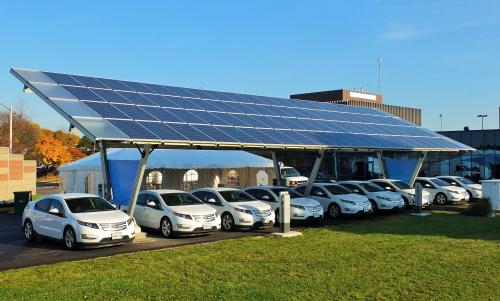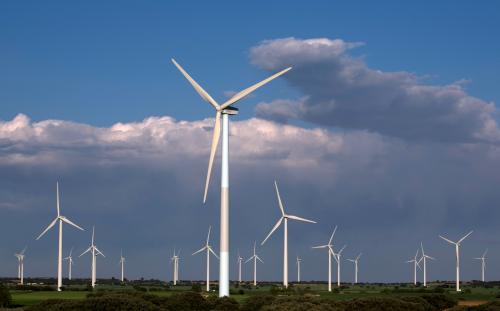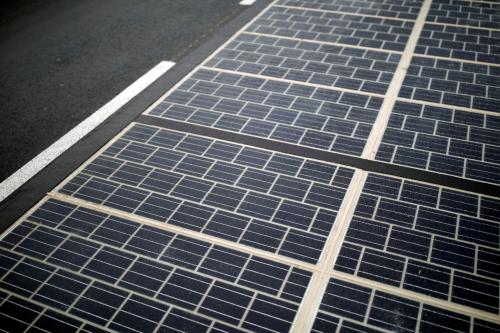Recently we released a brief flashing some warning lights about the shaky state of clean energy technology (cleantech) innovation trends at a moment of rising concerns about the federal commitment to low-carbon economic development.
Now, with President Trump pondering whether the United States should stay in or leave the Paris Agreement, we want to highlight some additional cautions about the way forward.
These cautions come in the form of a new analysis we released on May 16 tracking venture capital (VC) investment, and the takeaway is disquieting. A decade after Silicon Valley bet big on clean energy, and five years after a major bust, VC is continuing to pull back from the nation’s quest to commercialize revolutionary low-carbon technologies.
Such retrenchment is not good at a moment of great uncertainty about not just the Paris process but Trump’s proposed steep cuts to federal energy innovation programs.
To be sure, VC investment has played an undeniably important role backing dynamic start-ups that couldn’t get access to traditional bank financing. Think here of well-known companies like Boston Power, Nest, Silver Spring Networks, and Solar City (now absorbed into Tesla). In fact, think of Tesla itself! Successes like Tesla—for a while—licensed the idea that VC, even with its non-negotiable demands for huge returns on very fast timelines, would become the ideal financing mechanism in the cleantech sector and play a key role in driving a zero-carbon revolution.
And yet, our evidence—which follows important earlier analyses by the MIT Energy Initiative and Shikhar Ghosh and Ramana Nanda—suggests that the VC model has not lived up to its hype in cleantech and that the traditional VC model may in fact be ill-suited for many cleantech sectors.
Four findings jump out of our analysis:
- U.S. cleantech venture capital investment has declined sharply since 2011. Slipping to $5.2 billion last year, VC in the sector is running about 30 percent below its 2011 levels.

- Cleantech VC investment is disproportionately concentrated in a few metropolitan areas. Just four metros—San Francisco, San Jose, Boston, and Los Angeles—account for 54 percent of all cleantech VC flows.

- Cleantech VC investment is biased toward late-stage deals and a few technology areas, with energy efficiency, solar, and transportation attracting more than half of the funding. Early-stage start-ups are getting less funding than before.
- Corporations and corporate VCs are filling in some of the gap left by traditional VC, but it may not be enough. The financing efforts point to new possibilities but are unlikely to carry the full load of needed early-stage funding. (See the full report for more details about the four findings from our analysis.)
As to what these findings mean for the future funding of successful clean energy start-ups, a primary takeaway is simply not to expect VCs to do what they won’t do. The VC industry writ-large mostly funds consumer-ready software (as the MIT group noted), so no one should be surprised by its shift away from risky clean energy materials, chemicals, and devices. Nor should anyone be looking to VCs to fund “deep technology” companies or ideas with long development cycles, heavy capital requirements, or the kind of general risk typical in clean energy.
Instead, expect a marginal contribution from VCs in funding interesting cleantech start-ups that combine existing technologies with software, the cloud, and sensors. A few examples would be Vivint (a smart-home company based out of Provo, Utah); Urban Volt (which finances and retrofits LED lighting installation in large commercial properties); and the ride-sharing and fleet-tracking apps that are now attracting top VC dollars.
At the same time, the retrenchment of VC underscores the need for the emergence of new and more realistic finance solutions that fit particular technology and commercialization needs.
Some of the needed responses exist as standing government programs, and should not be shut down. The present moment, for example, would be a spectacularly bad time to eliminate the U.S. Department of Energy’s Advanced Research Projects Agency-Energy (ARPA-E) and it’s Loan Guarantee Program (LGP) as per President Trump’s recent budget proposal. Each of those programs supports technologies too risky for bank financing and so can help with the kind of investments the VCs are pulling back from. The same goes for an array of “technology-to-market” programs run through DOE’s national laboratories. These are also helpfully focused on accelerating the move of compelling inventions toward market impacts. Likewise, states and localities have the opportunity to deploy locally-focused clean energy investment and/or enterprise development funds that provide formal business development and investment support for local clean energy start-ups to address funding gaps and increase business opportunities.
Beyond that, and perhaps most urgently, the cleantech sector needs to experiment in its own right with new finance models designed to bridge resource gaps. Most notably, corporations and corporate VCs are going to need to play a larger role in financing start-ups and scaling up new businesses. To be sure, genuine market failures impede some of this work. However, Bill Gates’ Breakthrough Energy Coalition of billionaires reflects the potential of new, deep-pocketed actors to put patient risk capital to work in meaningful ways attentive to what might and won’t work. Nor need this be a mere sideshow: the Coalition’s Breakthrough Energy Ventures (BEV) fund recently committed to invest $1 billion in cleantech companies over the next 20 years. That’s meaningful funding. True, much more investment will be needed with that profile of patience and risk acceptance, especially if federal energy innovation programs are cut further. Nevertheless, BEV is a promising start that points in a good direction.
All of which points to the key point: the VC era is over for cleantech. Now it’s time to work out a new approach, with or without a supportive federal government.






Commentary
Clean energy’s shifting reality: Venture capital recedes, but what’s next?
May 30, 2017